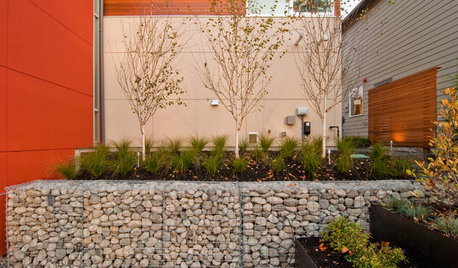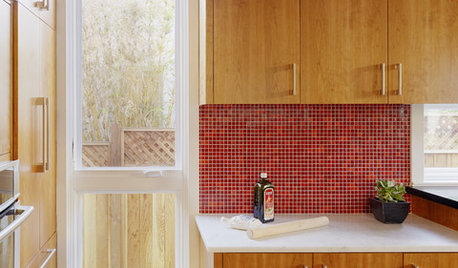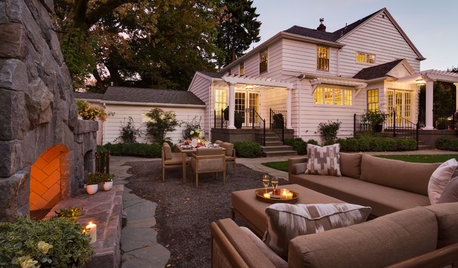Turface vs lava rock???
emgardener
16 years ago
Featured Answer
Sort by:Oldest
Comments (26)
tapla (mid-Michigan, USDA z5b-6a)
16 years agolast modified: 9 years agohitexplanter
16 years agolast modified: 9 years agoRelated Discussions
Where to find small lava rock or Gran-I-Grit in FL?
Comments (23)I'm in Melboure, FL and I want to use the Gran-i-grit as landscape gravel in a Japanese style garden. As per the following from the Brooklyn Botanic Garden Record, Plants & Garden 1961-62 (new series vol. 17 no. 4) The "Sand Gardens" Of Japan ...there are centuries-old "abstract" gardens in Japan in which sand or gravel are used more frequently, because it can be raked in meaningful patterens. In constructing the replica of the Ryoanji Temple Stone Garden at Brooklyn Botanic Garden, the gravel problem required a satisfactory solution. Washed gravel cannot satisfactorry be raked into surface patterens. Crushed gravel of uniformly-sized particles can be raked into patterens, but if it is to hold the pattern and at the same time present a satisfactory appearance (texture, light and shadow, etc.), it is necessary to combine two or three sizes of gravel particles. After several experiments, it was found that poultry grit from the North Carolina Granite Corporation, Mt Airy, NC came closet to giving the effect obtained by the Japanese in their Ryoanji Garden in Kyoto. Of the many size combinations we tested, one of the best proved to be: 2 parts "Grower" size 1 part "Turkey" size 1 part "Turkey Finisher" The different sizes were thoroughly mixed, applied evenly over a flat surface, and raked into a the "wavelet" pattern. The mixture can be recommended both for texture and holding quality. The wavelet pattern holds its form for several weeks, depending on the weather. While mixtures with a higher percentage of small grit held the pattern very satisfactory, they were chaclky in appearance and did not resemble the orginal Ryoanji mix. --- Landon H. Winchester, (Assistant Horticulturist, Brooklyn Botanic Garden). I added the following: http://www.ncgranite.com/gritmailer.pdf grower: 3/32 - 3/16 inch (2.3813 - 4.7625 mm) turkey: 5/16 - 7/16 inch (7.9375 - 11.1125 mm) turkey finisher: 7/16 - 5/8 inch (11.1125 - 15-8725 mm) Here is a link that might be useful: Gran-i-grit broucher...See MorePea gravel, construction sand, or lava rocks?
Comments (15)1)top (12:00) pourus pumice 2)right side (3:00) sifted for size scorsa 3)bottom (6:00) dry stall **avalable at farm feed and supply stores 4)left side (9:00) poultry grit ** avalable ay arm feed and suply stores 5) Center composted gravel * Also sifted for size having different shapes and sizes of granite in it including courser sifted SAND. Aqaruim gravel in this pic would be okay to use primarlay as a top dressing and maybe a piece or two ( small amount) in a grity mix soil but it's just to polished or not pourus enough to be relaiable. Personaly I wouldn't use the AKA river polished materails as an ingrediant in part of a gritty mix. There proberly is a Ph balance use or a potted plant application ( Proberly a few 1000 if I had to guess.) for it but I hadn't used what the google pic shows in anything here. Keep it simple. Even in 100 % pourus sifted sand a lithop is at a five star Ritz Carlton when potted here. While out grit shoping think sizeable by sifting materails that are both pourus and sharp. This post was edited by nomen_nudum on Thu, Jun 26, 14 at 16:04...See MorePumice VS Lava rock VS charcoal VS depth
Comments (7)My understanding of going from pebbles at the bottom to progressively smaller and smaller particles above that, is that if you lay pebbles and then put fine soil directly on top of them the soil will simply fill the air pockets you are trying to create with the pebbles. That method is not in favor currently- most recommend you don't need pebbles at the bottom, just well-drained 'soilless' soil with no potting soil. I don't use charcoal, but only because I don't understand its purpose fully that cannot be accomplished another way. If you are growing succulents in a pot with no drain holes, I don't recommend it and can't help you with tips in that environment. Letting soil of succulents dry out keeps the roots from rotting. At watering time, watering thoroughly three times until water is draining freely each time flushes the soil, helping to prevent buildup of minerals, and ensures all the roots receive moisture....See MoreDo moisture meters detect water in pumice, lava rock, turface, etc?
Comments (1)It may be that the meters require a more continuous volume of water to work well. Also salts in the water may give false readings. Some methods used for irrigation scheduling include Container Weight, Inserting a chopstick into medium for a while then checking it for a certain wetness, or checking the medium thru the drainage hole ( bottom layer will wetter than surface)....See Morelegacy
16 years agolast modified: 9 years agoemgardener
16 years agolast modified: 9 years agohitexplanter
16 years agolast modified: 9 years agonpthaskell
15 years agolast modified: 9 years agogojosan
15 years agolast modified: 9 years agonpthaskell
15 years agolast modified: 9 years agonpthaskell
15 years agolast modified: 9 years agonpthaskell
15 years agolast modified: 9 years agogojosan
15 years agolast modified: 9 years agogojosan
15 years agolast modified: 9 years agonpthaskell
15 years agolast modified: 9 years agonpthaskell
15 years agolast modified: 9 years agonpthaskell
15 years agolast modified: 9 years agonpthaskell
15 years agolast modified: 9 years agozeckron
15 years agolast modified: 9 years agonpthaskell
15 years agolast modified: 9 years agonpthaskell
15 years agolast modified: 9 years agonpthaskell
15 years agolast modified: 9 years agogojosan
15 years agolast modified: 9 years agogojosan
15 years agolast modified: 9 years agozeckron
15 years agolast modified: 9 years agoclibanarius
15 years agolast modified: 9 years agokayjones
12 years agolast modified: 9 years ago
Related Stories

LANDSCAPE DESIGNGarden Walls: Gabion Evolves From Functional to Fabulous
The permeable rock-, concrete- or glass-filled steel cages are showing up as retaining walls, planters, benches and more
Full Story
BATHROOM DESIGNGo Au Naturel in the Bath With Beautiful Stone
Add rocks and pebbles to your bathroom design for organic texture and practicality too
Full Story
HOUZZ TOURSHouzz Tour: Island Living
Lush Colors and Natural Materials Create the Ultimate Hawaiian Vacation Home
Full Story
TROPICAL STYLEHouzz Tour: Say Aloha to Tropical Beachside Splendor
Mother-of-pearl walls set the stage for a Hawaiian paradise home that swims with laid-back glamour
Full Story
GARDENING AND LANDSCAPINGHow to Make a Pond
You can make an outdoor fish paradise of your own, for less than you might think. But you'll need this expert design wisdom
Full Story
KITCHEN DESIGNKitchen Color: 15 Ravishing Red Backsplashes
Bring some zing to your kitchen with a backsplash of ruby-colored tiles or back-painted glass
Full Story
GARDENING GUIDESGardening Solutions for Heavy Clay Soils
What’s a gardener to do with soil that’s easily compacted and has poor drainage? Find out here
Full Story
GARDENING GUIDESHow to Pick a Mulch — and Why Your Soil Wants It
There's more to topdressing than shredded wood. Learn about mulch types, costs and design considerations here
Full Story
LANDSCAPE DESIGNCalifornia Says Goodbye to the Sprawling Ornamental Lawn
New state rules will effectively limit turfgrass to 25 percent of the landscape in most new and renovated yards
Full Story
GARDENING AND LANDSCAPINGHouzz Survey: See What Homeowners Are Doing With Their Landscapes Now
Homeowners are busy putting in low-maintenance landscapes designed for outdoor living, according to the 2015 Houzz landscaping survey
Full Story


legacy